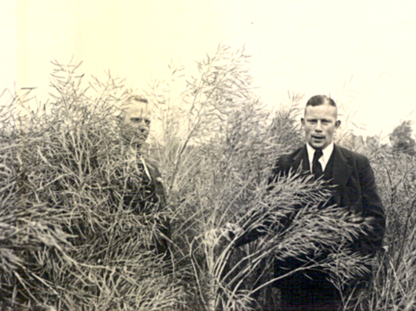Timeline
| 1931 | Founded by Peter Hartwig Petersen in Unewatt (Angeln) |
| 1938 | Propagation of marrow-stem kale and swedes |
| 1943 | Storage expansion in Husby - 1500 tonne capacity |
| 1962 | Paul Baecker joins as Head of Seed Cultivation |
| 1962 | Erection of a new building covering 1,200 sq metres in Lundsgaard with offices, cleaning plants and warehouse |
| 1969 | A. Sören Petersen joins the company. Purchase of the Schneider company. New focus: Cultivation and seed production for catch crops. |
| 1969 | PARCOUR German ryegrass makes the grass greener |
| 1971 | Joined SAATEN-UNION GmbH as an associate |
| 1974 | A. Sören Petersen takes over management of the company |
| 1978 | Protection for ANGELIA, the first variety of phacelia in Germany |
| 1980 | Approval of the world’s first catch crop varieties to biologically fight beet cyst nematodes: PEGLETTA oil radish |
| 1982 | Joined Hybro GbR as an associate. Cultivation and propagation of hybrid rye. |
| 1987 | KRAKA winter wheat successful in Germany, approval of LUKAS winter triticale |
| 1988 | Synbrid® winter rye varieties MERKATOR & DOMINATOR widely distributed throughout Europe |
| 1996 | Foundation and main shareholder of Raps GbR. Cultivation and propagation of quality rapeseed. |
| 1996 | World’s first oil radish variety COLONEL achieves resistance class 1 against beet cyst nematodes. |
| 1998 | Paul Baecker, long-serving Head of Seed Cultivation, retires. Michaela Schlathölter takes over his responsibilities. |
| 1999 | EIFFEL is the largest variety of German winter peas |
| 2002 | Introduction of first varieties and mixtures for biofumigation |
| 2004 | DEFENDER oil radish opens up a new performance category with multi-level resistance |
| 2007 | Climate-controlled greenhouse is built |
| 2010 | Approval of PRATEX, Germany's first variety of bristle oat, to fight pratylenchus penetrans (root-knot nematodes) |
| 2010 | Matz Petersen joins as manager |
| 2011 | Outsourcing of rapeseed activities and strategic reorientation focussing on catch crops, legumes and cereals |
| 2012 | Successful introduction of viterra® catch crop mixtures |
| 2013 | New 18,000 sq metre seed preparation plant built in Sárbogárd, Hungary |
| 2016 | A. Sören Petersen passes the torch on to his son Matz Petersen and focuses on new projects |
| 2015 | Two mixture plants built in Lundsgaard with a capacity of over 100 tonnes/day |
| 2016 | Approval of BIRGIT field beans specially suited for ecological farming |
| 2017 | Introduction of viterra® eco-mixtures |
| 2019 | Approval of new legumes for catch crop use, common vetches NEON and ARGON |








